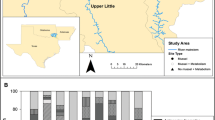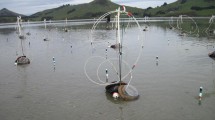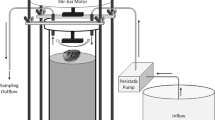Abstract
The impacts of animals on the biogeochemical cycles of major bioelements like C, N, and P are well-studied across ecosystem types. However, more than 20 elements are necessary for life. The feedbacks between animals and the biogeochemical cycles of the other bioelements are an emerging research priority. We explored how much freshwater mussels (Bivalvia: Unionoida) were related to variability in ecosystem pools of 10 bioelements (Ca, Cu, Fe, K, Mn, Na, Mg, P, S and Zn) in streams containing a natural mussel density gradient in the US Interior Highlands. We studied the concentrations of these bioelements across the aquatic-terrestrial interface—in the porewater of riverine gravel bars, and the emergent macrophyte Justicia americana. Higher mussel density was associated with increased calcium in gravel bars and macrophytes. Mussel density also correlated with variability in iron and other redox-sensitive trace elements in gravel bars and macrophytes, although this relationship was mediated by sediment grain size. We found that two explanations for the patterns we observed are worthy of further research: (1) increased calcium availability in gravel bars near denser mussel aggregations may be a product of the buildup and dissolution of shells in the gravel bar, and (2) mussels may alter redox conditions, and thus elemental availability in gravel bars with fine sediments, either behaviorally or through physical structure provided by shell material. A better understanding of the physical and biogeochemical impacts of animals on a wide range of elemental cycles is thus necessary to conserve the societal value of freshwater ecosystems.





Similar content being viewed by others
Data availability
The datasets used and analyzed during the current study are uploaded to Open Science Framework and can be found here (https://osf.io/dahyr/).
References
Allen DC, Vaughn CC, Kelly JF et al (2012) Bottom-up biodiversity effects increase resource subsidy flux between ecosystems. Ecology 93:2165–2174. https://doi.org/10.1890/11-1541.1
Allen DC, Galbraith HS, Vaughn CC, Spooner DE (2013) A tale of two rivers: Implications of water management practices for mussel biodiversity outcomes during droughts. Ambio 42:881–891. https://doi.org/10.1007/s13280-013-0420-8
Aller R (1990) Bioturbation and manganese cycling in hemipelagic sediments. Philos Trans R Soc Lond Ser Math Phys Sci 331:51–68. https://doi.org/10.1098/rsta.1990.0056
Allgeier JE, Burkepile DE, Layman CA (2017) Animal pee in the sea: consumer-mediated nutrient dynamics in the world’s changing oceans. Glob Change Biol 23:2166–2178. https://doi.org/10.1111/gcb.13625
Atkinson CL, Vaughn CC (2015) Biogeochemical hotspots: Temporal and spatial scaling of the impact of freshwater mussels on ecosystem function. Freshw Biol 60:563–574. https://doi.org/10.1111/fwb.12498
Atkinson CL, Sansom BJ, Vaughn CC, Forshay KJ (2018) Consumer aggregations drive nutrient dynamics and ecosystem metabolism in nutrient-limited systems. Ecosystems 21:521–535. https://doi.org/10.1007/s10021-017-0166-4
Barnes DJ, Devereux MJ (1984) Productivity and calcification on a coral reef: A survey using pH and oxygen electrode techniques. J Exp Mar Biol Ecol 79:213–231. https://doi.org/10.1016/0022-0981(84)90196-5
Ben-David M, Hanley TA, Schell DM (1998) Fertilization of terrestrial vegetation by spawning Pacific salmon: the role of flooding and predator activity. Oikos 83:47–55
Bódis E, Tóth B, Szekeres J et al (2014) Empty native and invasive bivalve shells as benthic habitat modifiers in a large river. Limnologica 49:1–9. https://doi.org/10.1016/j.limno.2014.07.002
Boyd PW, Watson AJ, Law CS et al (2000) A mesoscale phytoplankton bloom in the polar Southern Ocean stimulated by iron fertilization. Nature 407:695–702. https://doi.org/10.1038/35037500
Brewer SK, Fox G, Zhou Y, Alexander J (2019) Understanding the impacts of surface-groundwater conditions on stream fishes under altered baseflow conditions. U.S. Department of Interior, Fish and Wildlife Service, Cooperator Science Series FWS/CSS-136–2020, Washington, D.C. https://doi.org/10.3996/css49046075
Bump JK (2018) Fertilizing riparian forests: nutrient repletion across ecotones with trophic rewilding. Philos Trans R Soc B Biol Sci. https://doi.org/10.1098/rstb.2017.0439
Ceacero F, Landete-Castillejos T, Miranda M et al (2014) Why do cervids feed on aquatic vegetation? Behav Processes 103:28–34. https://doi.org/10.1016/j.beproc.2013.10.008
Curley EAM, Thomas R, Adams CE, Stephen A (2022) Adaptive responses of freshwater pearl mussels, Margaritifera margaritifera, to managed drawdowns. Aquat Conserv Mar Freshw Ecosyst 32:466–483. https://doi.org/10.1002/aqc.3759
Fashingbauer BA, Moyle JB (1963) Nutritive value of red-Osier Dogwood and mountain maple as deer browse. J Minn Acad Sci 31:73–81
Freeland WJ, Choquenot D (1990) Determinants of herbivore carrying capacity: plants, nutrients, and Equus asinus in Northern Australia. Ecology 71:589–597. https://doi.org/10.2307/1940312
Graham RD, Stangoulis JCR (2003) Trace element uptake and distribution in plants. J Nutr 133:1502S-1505S
Haag WR (2012) North American Freshwater Mussels: natural history, ecology, and conservation. Cambridge University Press, New York
Harrison HE, Darrow DC, Yannet H (1936) The total electrolyte content of animals and its probable relation to the distribution of body water. J Biol Chem 113:515–529. https://doi.org/10.1016/s0021-9258(18)74873-4
Hopper GW, Gido KB, Vaughn CC et al (2018) Biomass distribution of fishes and mussels mediates spatial and temporal heterogeneity in nutrient cycling in streams. Oecologia 188:1133–1144. https://doi.org/10.1007/s00442-018-4277-1
Horowitz AJ, Elrick KA (1987) The relation of stream sediment surface area, grain size and composition to trace element chemistry. Appl Geochem 2:437–451. https://doi.org/10.1016/0883-2927(87)90027-8
Kaspari M (2021) The invisible hand of the periodic table: How micronutrients shape ecology. Annu Rev Ecol Evol Syst 52:199–219
Kaspari M, de Beurs KM, Welti EAR (2021) How and why plant ionomes vary across North American grasslands and its implications for herbivore abundance. Ecology 102:e03459. https://doi.org/10.1002/ecy.3459
Kreulen D (1975) Wildebeest habitat selection on the Serengeti plains, Tanzania, in relation to calcium and lactation: a preliminary report. Afr J Ecol 13:297–304. https://doi.org/10.1111/j.1365-2028.1975.tb00141.x
Lopez JW, Parr TB, Allen DC, Vaughn CC (2020) Animal aggregations promote emergent aquatic plant production at the aquatic–terrestrial interface. Ecology 101:1–8. https://doi.org/10.1002/ecy.3126
Lopez JW, Allen DC, Vaughn CC (2022) White-tailed deer consumption of emergent macrophytes mediates aquatic-to-terrestrial nutrient flows. Ecol Evol 12:e9257. https://doi.org/10.1002/ece3.9257
Lymbery AJ, Ma L, Lymbery SJ et al (2021) Burrowing behavior protects a threatened freshwater mussel in drying rivers. Hydrobiologia 848:3141–3152. https://doi.org/10.1007/s10750-020-04268-0
Matisoff G, Fisher JB, Matis S (1985) Effects of benthic macroinvertebrates on the exchange of solutes between sediments and freshwater. Hydrobiologia 122:19–33. https://doi.org/10.1007/BF00018956
McNaughton SJ (1985) Ecology of a grazing ecosystem: the Serengeti. Ecol Monogr 55:259–294
McNaughton SJ, Banyikwa FF, McNaughton MM (1997) Promotion of the cycling of diet-enhancing nutrients by African Grazers. Science 278:1798–1800. https://doi.org/10.1126/science.278.5344.1798
Meysman FJR, Middelburg JJ, Heip CHR (2006) Bioturbation: a fresh look at Darwin’s last idea. Trends Ecol Evol 21:688–695. https://doi.org/10.1016/j.tree.2006.08.002
Morgan KM, Kench PS (2016) Parrotfish erosion underpins reef growth, sand talus development and island building in the Maldives. Sediment Geol 341:50–57. https://doi.org/10.1016/j.sedgeo.2016.05.011
Newton TJ, Zigler SJ, Gray BR (2015) Mortality, movement and behaviour of native mussels during a planned water-level drawdown in the Upper Mississippi River. Freshw Biol 60:1–15. https://doi.org/10.1111/fwb.12461
OWRB (2017) Oklahoma Streams Report. Oklahoma Water Resources Board
Pabian SE, Ermer NM, Tzilkowski WM, Brittingham MC (2012) Effects of liming on forage availability and nutrient content in a forest impacted by acid rain. PLoS ONE 7:e39755. https://doi.org/10.1371/journal.pone.0039755
Parr TB, Vaughn CC, Gido KB (2019) Animal effects on dissolved organic carbon bioavailability in an algal controlled ecosystem. Freshw Biol 65:1298–1310. https://doi.org/10.1111/fwb.13438
Polis GA, Hurd SD (1996) Linking marine and terrestrial food webs: Allochthonous input from the ocean supports high secondary productivity on small Islands and coastal land communities. Am Nat 147:396–423. https://doi.org/10.1086/285858
R Core Team (2021) R: a language and environment for statistical computing
Roman J, Estes JA, Morissette L et al (2014) Whales as marine ecosystem engineers. Front Ecol Environ 12:377–385. https://doi.org/10.1890/130220
Schmitz OJ, Wilmers CC, Leroux SJ et al (2018) Animals and the zoogeochemistry of the carbon cycle. Science 362:eaar3213. https://doi.org/10.1126/science.aar3213
Sousa R, Varandas S, Cortes R et al (2012) Massive die-offs of freshwater bivalves as resource pulses. Ann Limnol Int J Limnol 48:105–112. https://doi.org/10.1051/limn/2012003
Sterner RW, Elser JJ (2002) Ecological stoichiometry: the biology of elements from molecules to the biosphere. Princeton University Press, Princeton
Strayer DL (1993) Macrohabitats of freshwater Mussels (Bivalvia: Unionacea) in streams of the Northern Atlantic Slope. J North Am Benthol Soc 12:236–246
Strayer DL, Malcom HM (2007) Shell decay rates of native and alien freshwater bivalves and implications for habitat engineering. Freshw Biol 52:1611–1617. https://doi.org/10.1111/j.1365-2427.2007.01792.x
Strayer D, Smith L (1994) Distribution, abundance, and roles of freshwater clams (Bivalvia, Unionidae) in the freshwater tidal Hudson River. Freshw Biol 31:239–248. https://doi.org/10.1111/j.1365-2427.1994.tb00858.x
Subalusky AL, Post DM (2019) Context dependency of animal resource subsidies. Biol Rev 94:517–538. https://doi.org/10.1111/brv.12465
Subalusky AL, Dutton CL, Rosi EJ, Post DM (2017) Annual mass drownings of the Serengeti wildebeest migration influence nutrient cycling and storage in the Mara River. Proc Natl Acad Sci USA 114:7647–7652. https://doi.org/10.1073/pnas.1614778114
Tredennick AT, Hooker G, Ellner SP, Adler PB (2021) A practical guide to selecting models for exploration, inference, and prediction in ecology. Ecology 102:e03336. https://doi.org/10.1002/ecy.3336
Vanni MJ (2002) Nutrient cycling by animals in freshwater ecosystems. Annu Rev Ecol Syst 33:341–370. https://doi.org/10.1146/annurev.ecolsys.33.010802.150519
Vaughn C (2003) The mussel fauna of the Glover River, Oklahoma. Proc Okla Acad Sci 83:1–6
Vaughn CC, Hoellein TJ (2018) Bivalve impacts in freshwater and marine ecosystems. Annu Rev Ecol Evol Syst 49:183–208. https://doi.org/10.1146/annurev-ecolsys-110617-062703
Webster JR, Patten BC (1979) Effects of watershed perturbation on stream potassium and calcium dynamics. Ecol Monogr 49:51–72. https://doi.org/10.2307/1942572
Wolman MG (1954) A method of sampling coarse river-bed material. Trans Am Geophys Union 35:951–956
Yatoo MI, Saxena A, Deepa PM et al (2013) Role of trace elements in animals: a review. Vet World 6:963–967. https://doi.org/10.14202/vetworld.2013.963-967
Zhang C, Yu Z, Zeng G et al (2014) Effects of sediment geochemical properties on heavy metal bioavailability. Environ Int 73:270–281. https://doi.org/10.1016/j.envint.2014.08.010
Acknowledgements
We thank A. Franzen, E. Higgins, the members of the Vaughn Lab, A. Cooper, M. Spikes, and P. Jeyasingh for assistance. We thank L. Souza, M. Kaspari, B. Hall, and an anonymous reviewer for comments that improved the manuscript. J. Hartwell designed Fig. 1. We also thank the landowners that allowed us access to our study rivers through their property. This paper is part of a dissertation at the University of Oklahoma and a contribution to the program of the Oklahoma Biological Survey.
Funding
Funding for this work was provided by the Oklahoma Department of Wildlife Conservation, the University of Oklahoma, Department of Biology, the Oklahoma Biological Survey, Western Ag Innovations, and the National Science Foundation (DEB 1457542).
Author information
Authors and Affiliations
Contributions
JWL and CCV designed the field studies. RNH conducted and advised on ICP-OES analyses. TBP assisted with the PRS® probe study and consulted on data analysis and interpretation. JWL wrote the initial manuscript and revised with input from all authors.
Corresponding author
Ethics declarations
Conflict of interest
The authors declare that they have no conflict of interest.
Additional information
Communicated by Robert O. Hall.
We used a multi-element approach to examine relationships between animal aggregations and ecosystems. This approach has potential to generate hypotheses regarding animals' biogeochemical impacts.
Supplementary Information
Below is the link to the electronic supplementary material.
Rights and permissions
Springer Nature or its licensor (e.g. a society or other partner) holds exclusive rights to this article under a publishing agreement with the author(s) or other rightsholder(s); author self-archiving of the accepted manuscript version of this article is solely governed by the terms of such publishing agreement and applicable law.
About this article
Cite this article
Lopez, J.W., Hartnett, R.N., Parr, T.B. et al. Ecosystem bioelement variability is associated with freshwater animal aggregations at the aquatic-terrestrial interface. Oecologia 202, 795–806 (2023). https://doi.org/10.1007/s00442-023-05437-3
Received:
Accepted:
Published:
Issue Date:
DOI: https://doi.org/10.1007/s00442-023-05437-3




